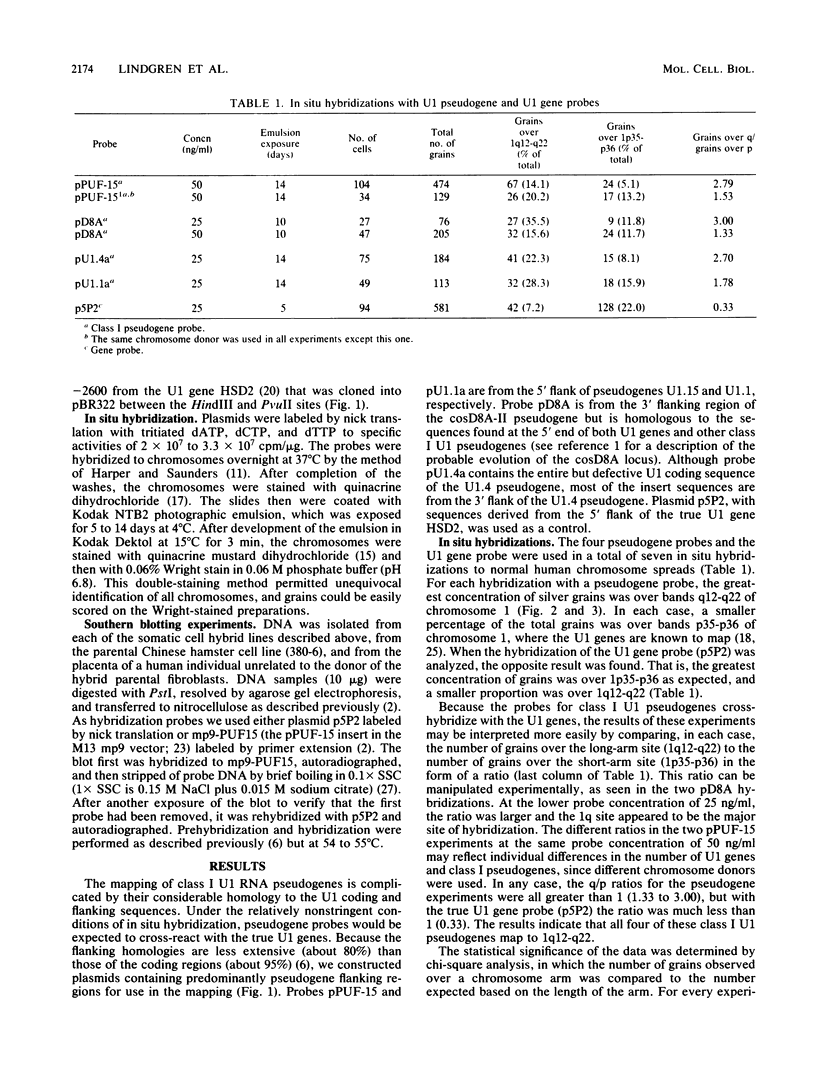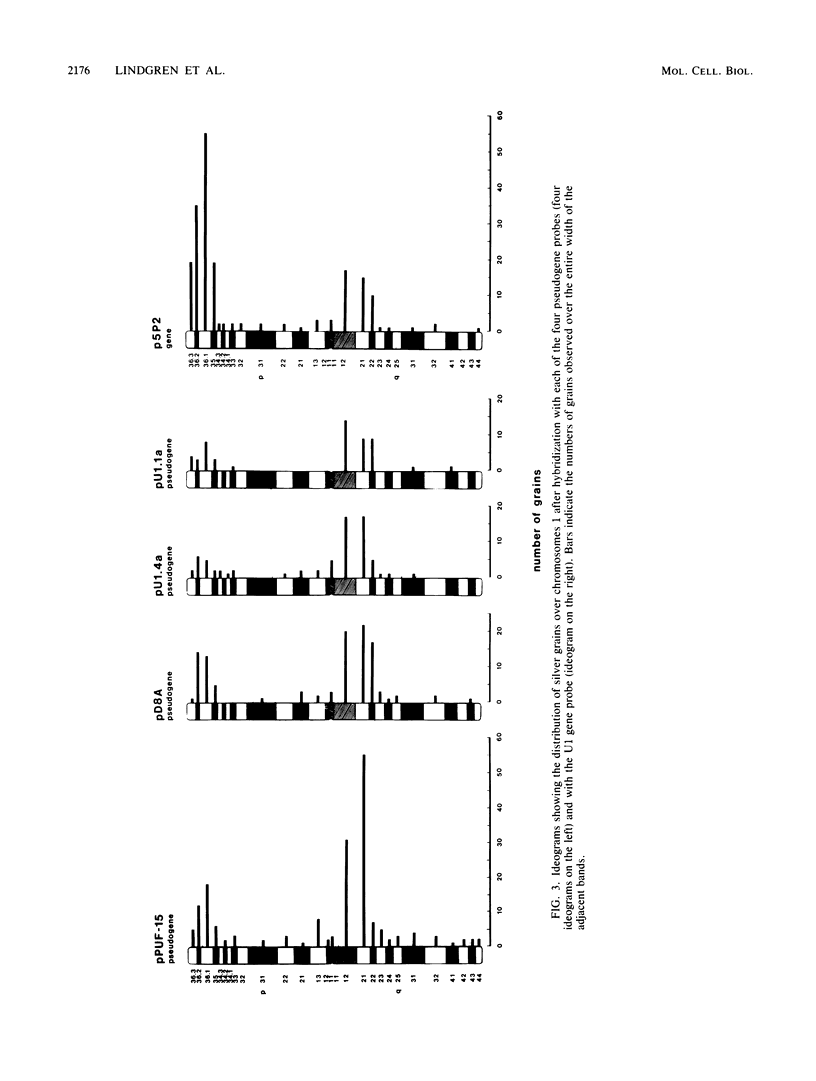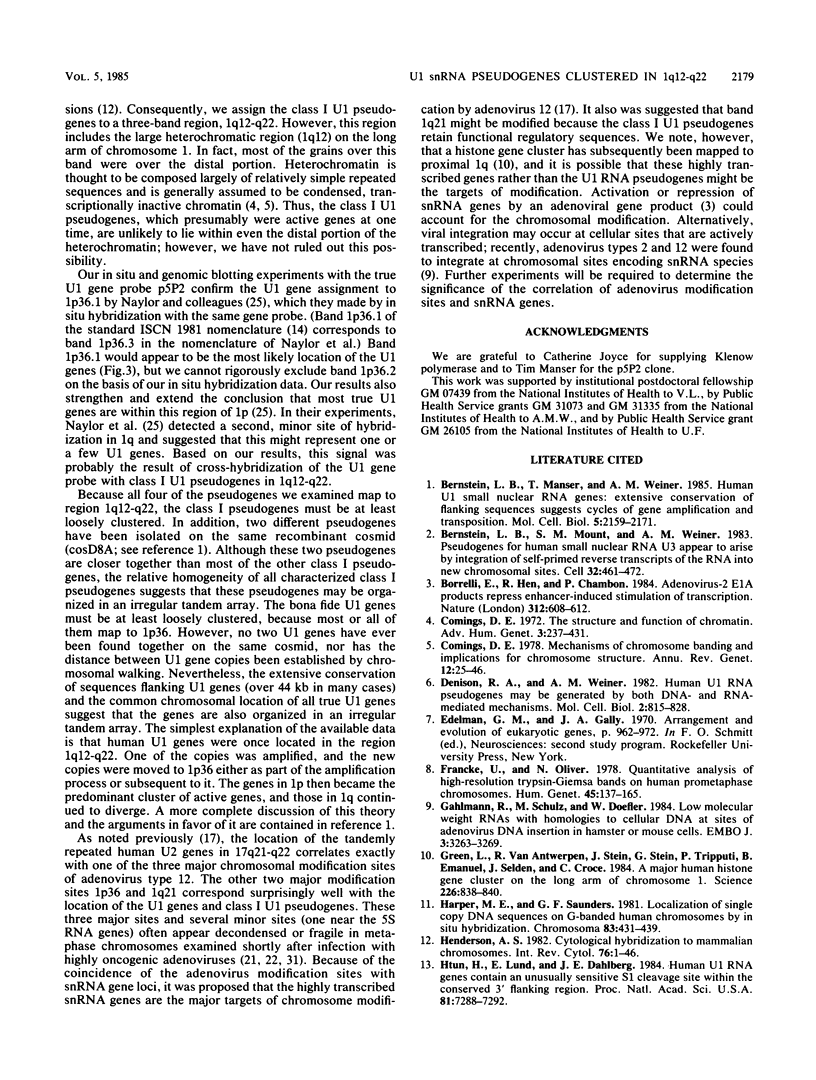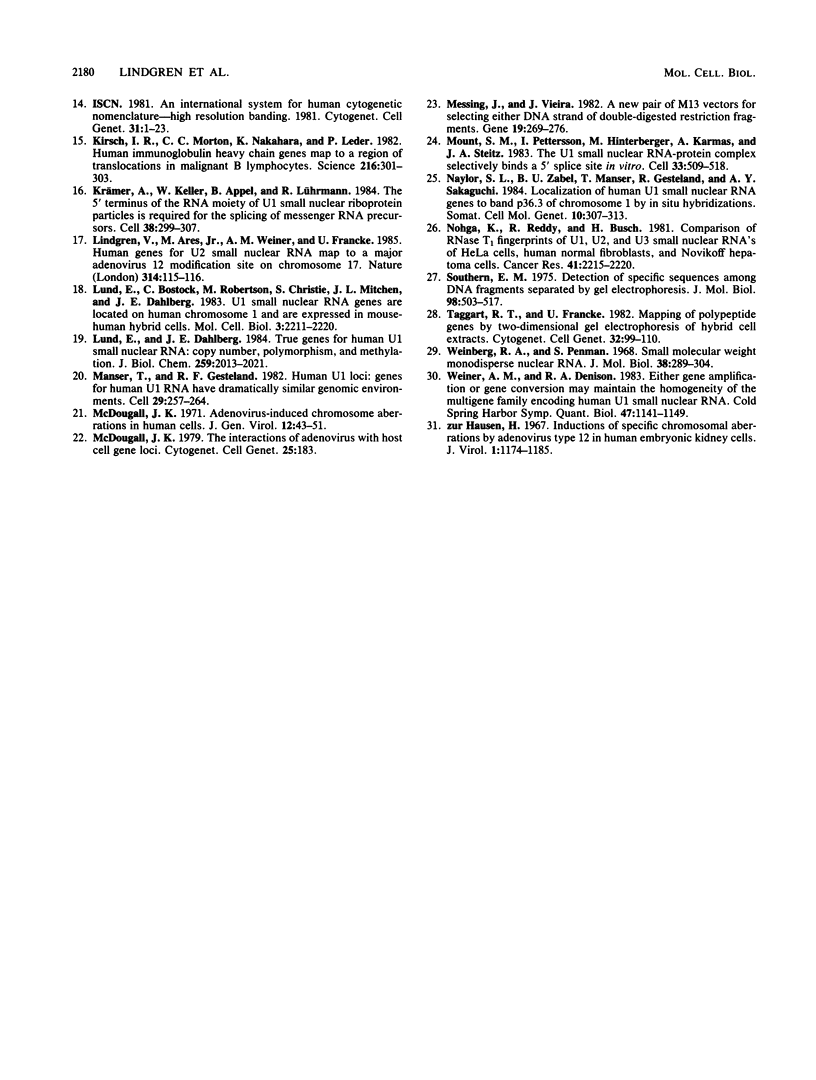Abstract
Human U1 small nuclear RNA is encoded by approximately 30 gene copies. All of the U1 genes share several kilobases of essentially perfect flanking homology both upstream and downstream from the U1 coding region, but remarkably, for many U1 genes excellent flanking homology extends at least 24 kilobases upstream and 20 kilobases downstream. Class I U1 RNA pseudogenes are abundant in the human genome. These pseudogenes contain a complete but imperfect U1 coding region and possess extensive flanking homology to the true U1 genes. We mapped four class I pseudogenes by in situ hybridization to the long arm of chromosome 1, bands q12-q22, a region distinct from the site on the distal short arm of chromosome 1 to which the U1 genes have been previously mapped (Lund et al., Mol. Cell. Biol. 3:2211-2220, 1983; Naylor et al., Somat. Cell Mol. Genet. 10:307-313, 1984). We confirmed our in situ hybridization results by genomic blotting experiments with somatic cell hybrid lines with translocation products of human chromosome 1. These experiments provide further evidence that class I U1 pseudogenes and the true U1 genes are not interspersed. The results, along with those published elsewhere (Bernstein et al., Mol. Cell. Biol. 5:2159-2171, 1985), suggest that gene amplification may be responsible for the sequence homogeneity of the human U1 gene family.
Full text
PDF








Images in this article
Selected References
These references are in PubMed. This may not be the complete list of references from this article.
- Bernstein L. B., Manser T., Weiner A. M. Human U1 small nuclear RNA genes: extensive conservation of flanking sequences suggests cycles of gene amplification and transposition. Mol Cell Biol. 1985 Sep;5(9):2159–2171. doi: 10.1128/mcb.5.9.2159. [DOI] [PMC free article] [PubMed] [Google Scholar]
- Bernstein L. B., Mount S. M., Weiner A. M. Pseudogenes for human small nuclear RNA U3 appear to arise by integration of self-primed reverse transcripts of the RNA into new chromosomal sites. Cell. 1983 Feb;32(2):461–472. doi: 10.1016/0092-8674(83)90466-x. [DOI] [PubMed] [Google Scholar]
- Borrelli E., Hen R., Chambon P. Adenovirus-2 E1A products repress enhancer-induced stimulation of transcription. Nature. 1984 Dec 13;312(5995):608–612. doi: 10.1038/312608a0. [DOI] [PubMed] [Google Scholar]
- Comings D. E. Mechanisms of chromosome banding and implications for chromosome structure. Annu Rev Genet. 1978;12:25–46. doi: 10.1146/annurev.ge.12.120178.000325. [DOI] [PubMed] [Google Scholar]
- Comings D. E. The structure and function of chromatin. Adv Hum Genet. 1972;3:237–431. doi: 10.1007/978-1-4757-4429-3_5. [DOI] [PubMed] [Google Scholar]
- Denison R. A., Weiner A. M. Human U1 RNA pseudogenes may be generated by both DNA- and RNA-mediated mechanisms. Mol Cell Biol. 1982 Jul;2(7):815–828. doi: 10.1128/mcb.2.7.815. [DOI] [PMC free article] [PubMed] [Google Scholar]
- Francke U., Oliver N. Quantitative analysis of high-resolution trypsin-giemsa bands on human prometaphase chromosomes. Hum Genet. 1978 Dec 18;45(2):137–165. doi: 10.1007/BF00286957. [DOI] [PubMed] [Google Scholar]
- Gahlmann R., Schulz M., Doefler W. Low molecular weight RNAs with homologies to cellular DNA at sites of adenovirus DNA insertion in hamster or mouse cells. EMBO J. 1984 Dec 20;3(13):3263–3269. doi: 10.1002/j.1460-2075.1984.tb02288.x. [DOI] [PMC free article] [PubMed] [Google Scholar]
- Green L., Van Antwerpen R., Stein J., Stein G., Tripputi P., Emanuel B., Selden J., Croce C. A major human histone gene cluster on the long arm of chromosome 1. Science. 1984 Nov 16;226(4676):838–840. doi: 10.1126/science.6494913. [DOI] [PubMed] [Google Scholar]
- Harper M. E., Saunders G. F. Localization of single copy DNA sequences of G-banded human chromosomes by in situ hybridization. Chromosoma. 1981;83(3):431–439. doi: 10.1007/BF00327364. [DOI] [PubMed] [Google Scholar]
- Henderson A. S. Cytological hybridization to mammalian chromosomes. Int Rev Cytol. 1982;76:1–46. [PubMed] [Google Scholar]
- Htun H., Lund E., Dahlberg J. E. Human U1 RNA genes contain an unusually sensitive nuclease S1 cleavage site within the conserved 3' flanking region. Proc Natl Acad Sci U S A. 1984 Dec;81(23):7288–7292. doi: 10.1073/pnas.81.23.7288. [DOI] [PMC free article] [PubMed] [Google Scholar]
- Kirsch I. R., Morton C. C., Nakahara K., Leder P. Human immunoglobulin heavy chain genes map to a region of translocations in malignant B lymphocytes. Science. 1982 Apr 16;216(4543):301–303. doi: 10.1126/science.6801764. [DOI] [PubMed] [Google Scholar]
- Krämer A., Keller W., Appel B., Lührmann R. The 5' terminus of the RNA moiety of U1 small nuclear ribonucleoprotein particles is required for the splicing of messenger RNA precursors. Cell. 1984 Aug;38(1):299–307. doi: 10.1016/0092-8674(84)90551-8. [DOI] [PubMed] [Google Scholar]
- Lindgren V., Ares M., Jr, Weiner A. M., Francke U. Human genes for U2 small nuclear RNA map to a major adenovirus 12 modification site on chromosome 17. Nature. 1985 Mar 7;314(6006):115–116. doi: 10.1038/314115a0. [DOI] [PubMed] [Google Scholar]
- Lund E., Bostock C., Robertson M., Christie S., Mitchen J. L., Dahlberg J. E. U1 small nuclear RNA genes are located on human chromosome 1 and are expressed in mouse-human hybrid cells. Mol Cell Biol. 1983 Dec;3(12):2211–2220. doi: 10.1128/mcb.3.12.2211. [DOI] [PMC free article] [PubMed] [Google Scholar]
- Lund E., Dahlberg J. E. True genes for human U1 small nuclear RNA. Copy number, polymorphism, and methylation. J Biol Chem. 1984 Feb 10;259(3):2013–2021. [PubMed] [Google Scholar]
- Manser T., Gesteland R. F. Human U1 loci: genes for human U1 RNA have dramatically similar genomic environments. Cell. 1982 May;29(1):257–264. doi: 10.1016/0092-8674(82)90110-6. [DOI] [PubMed] [Google Scholar]
- McDougall J. K. Adenovirus-induced chromosome aberrations in human cells. J Gen Virol. 1971 Jul;12(1):43–51. doi: 10.1099/0022-1317-12-1-43. [DOI] [PubMed] [Google Scholar]
- Messing J., Vieira J. A new pair of M13 vectors for selecting either DNA strand of double-digest restriction fragments. Gene. 1982 Oct;19(3):269–276. doi: 10.1016/0378-1119(82)90016-6. [DOI] [PubMed] [Google Scholar]
- Mount S. M., Pettersson I., Hinterberger M., Karmas A., Steitz J. A. The U1 small nuclear RNA-protein complex selectively binds a 5' splice site in vitro. Cell. 1983 Jun;33(2):509–518. doi: 10.1016/0092-8674(83)90432-4. [DOI] [PubMed] [Google Scholar]
- Naylor S. L., Zabel B. U., Manser T., Gesteland R., Sakaguchi A. Y. Localization of human U1 small nuclear RNA genes to band p36.3 of chromosome 1 by in situ hybridization. Somat Cell Mol Genet. 1984 May;10(3):307–313. doi: 10.1007/BF01535252. [DOI] [PubMed] [Google Scholar]
- Nohga K., Reddy R., Busch H. Comparison of RNase T1 fingerprints of U1, U2, and U3 small nuclear RNA's of HeLa cells, human normal fibroblasts, and Novikoff hepatoma cells. Cancer Res. 1981 Jun;41(6):2215–2220. [PubMed] [Google Scholar]
- Southern E. M. Detection of specific sequences among DNA fragments separated by gel electrophoresis. J Mol Biol. 1975 Nov 5;98(3):503–517. doi: 10.1016/s0022-2836(75)80083-0. [DOI] [PubMed] [Google Scholar]
- Taggart R. T., Francke U. Mapping of polypeptide genes by two-dimensional gel electrophoresis of hybrid cell extracts. Cytogenet Cell Genet. 1982;32(1-4):99–110. doi: 10.1159/000131690. [DOI] [PubMed] [Google Scholar]
- Weinberg R. A., Penman S. Small molecular weight monodisperse nuclear RNA. J Mol Biol. 1968 Dec;38(3):289–304. doi: 10.1016/0022-2836(68)90387-2. [DOI] [PubMed] [Google Scholar]
- Weiner A. M., Denison R. A. Either gene amplification or gene conversion may maintain the homogeneity of the multigene family encoding human U1 small nuclear RNA. Cold Spring Harb Symp Quant Biol. 1983;47(Pt 2):1141–1149. doi: 10.1101/sqb.1983.047.01.129. [DOI] [PubMed] [Google Scholar]
- Zur Hausen H. Induction of specific chromosomal aberrations by adenovirus type 12 in human embryonic kidney cells. J Virol. 1967 Dec;1(6):1174–1185. doi: 10.1128/jvi.1.6.1174-1185.1967. [DOI] [PMC free article] [PubMed] [Google Scholar]




